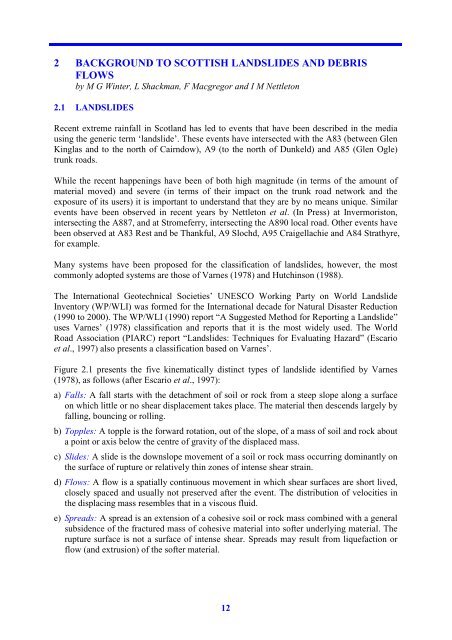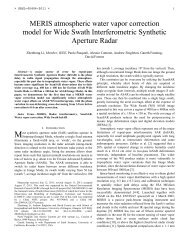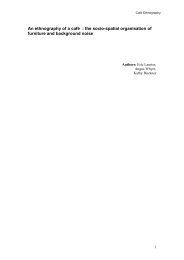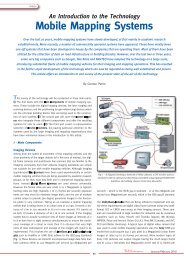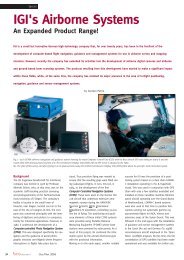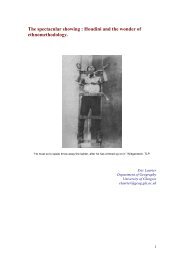Scottish Road Network Landslides Study - University of Glasgow
Scottish Road Network Landslides Study - University of Glasgow
Scottish Road Network Landslides Study - University of Glasgow
Create successful ePaper yourself
Turn your PDF publications into a flip-book with our unique Google optimized e-Paper software.
2 BACKGROUND TO SCOTTISH LANDSLIDES AND DEBRIS<br />
FLOWS<br />
by M G Winter, L Shackman, F Macgregor and I M Nettleton<br />
2.1 LANDSLIDES<br />
Recent extreme rainfall in Scotland has led to events that have been described in the media<br />
using the generic term ‘landslide’. These events have intersected with the A83 (between Glen<br />
Kinglas and to the north <strong>of</strong> Cairndow), A9 (to the north <strong>of</strong> Dunkeld) and A85 (Glen Ogle)<br />
trunk roads.<br />
While the recent happenings have been <strong>of</strong> both high magnitude (in terms <strong>of</strong> the amount <strong>of</strong><br />
material moved) and severe (in terms <strong>of</strong> their impact on the trunk road network and the<br />
exposure <strong>of</strong> its users) it is important to understand that they are by no means unique. Similar<br />
events have been observed in recent years by Nettleton et al. (In Press) at Invermoriston,<br />
intersecting the A887, and at Stromeferry, intersecting the A890 local road. Other events have<br />
been observed at A83 Rest and be Thankful, A9 Slochd, A95 Craigellachie and A84 Strathyre,<br />
for example.<br />
Many systems have been proposed for the classification <strong>of</strong> landslides, however, the most<br />
commonly adopted systems are those <strong>of</strong> Varnes (1978) and Hutchinson (1988).<br />
The International Geotechnical Societies’ UNESCO Working Party on World Landslide<br />
Inventory (WP/WLI) was formed for the International decade for Natural Disaster Reduction<br />
(1990 to 2000). The WP/WLI (1990) report “A Suggested Method for Reporting a Landslide”<br />
uses Varnes’ (1978) classification and reports that it is the most widely used. The World<br />
<strong>Road</strong> Association (PIARC) report “<strong>Landslides</strong>: Techniques for Evaluating Hazard” (Escario<br />
et al., 1997) also presents a classification based on Varnes’.<br />
Figure 2.1 presents the five kinematically distinct types <strong>of</strong> landslide identified by Varnes<br />
(1978), as follows (after Escario et al., 1997):<br />
a) Falls: A fall starts with the detachment <strong>of</strong> soil or rock from a steep slope along a surface<br />
on which little or no shear displacement takes place. The material then descends largely by<br />
falling, bouncing or rolling.<br />
b) Topples: A topple is the forward rotation, out <strong>of</strong> the slope, <strong>of</strong> a mass <strong>of</strong> soil and rock about<br />
a point or axis below the centre <strong>of</strong> gravity <strong>of</strong> the displaced mass.<br />
c) Slides: A slide is the downslope movement <strong>of</strong> a soil or rock mass occurring dominantly on<br />
the surface <strong>of</strong> rupture or relatively thin zones <strong>of</strong> intense shear strain.<br />
d) Flows: A flow is a spatially continuous movement in which shear surfaces are short lived,<br />
closely spaced and usually not preserved after the event. The distribution <strong>of</strong> velocities in<br />
the displacing mass resembles that in a viscous fluid.<br />
e) Spreads: A spread is an extension <strong>of</strong> a cohesive soil or rock mass combined with a general<br />
subsidence <strong>of</strong> the fractured mass <strong>of</strong> cohesive material into s<strong>of</strong>ter underlying material. The<br />
rupture surface is not a surface <strong>of</strong> intense shear. Spreads may result from liquefaction or<br />
flow (and extrusion) <strong>of</strong> the s<strong>of</strong>ter material.<br />
12


